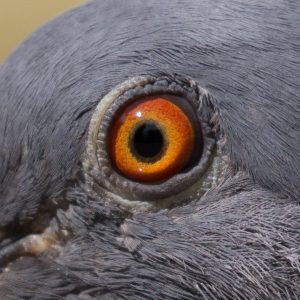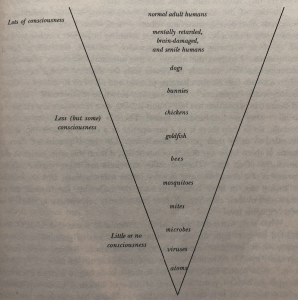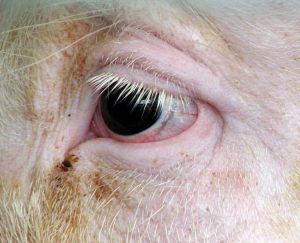by Joshua Wilbur

I would never call myself a birdwatcher. I’m confident—arrogant even—about blue jays and cardinals, but everything else is a crapshoot. I identify finches as sparrows, sparrows as hawks, hawks as starlings. I’m more often wrong than right.
That said, I do like to watch birds. In college, I would go to the Boston Aquarium to see the African penguins. Peering over the central railing, I would pick out a single penguin from the group and follow its (his? her?) every move for as long as possible. Into the water, out of the water, into the water again…
These days I spend a lot of time in Central Park, where countless pigeons roam the paths. When I’m not in a rush, I’ll find a bench and read for awhile, and, inevitably, the legion arrives. Again, I like to pick out one member of the group and see what it does. Whether penguin or pigeon (or finch or sparrow or gull), what fascinates me about watching birds is how contingent—how utterly arbitrary— their actions can seem.
Why does the bird take three steps this way instead of that way?
Why does it fly to that tree in particular?
Why does it return to the ground at my feet, turn a few circles, and continue its march along the sidewalk?
I understand, of course. It’s looking for food. But there’s a wide gulf between a pigeon’s world and mine. And I feel that divide most strongly when I look into a bird’s eyes. I’ll stare down at a pigeon, focus on the red and orange and black of its vigilant eye, and think about a very old question: “Is anyone in there?”

For a long time, the answer was no. Aristotle held that animals are without reason, without language, driven purely by instinct. Within the Great Chain of Being, animals ranked above plants and minerals but below humans, who alone possessed access to the divine through the light of the rational soul. Animals move; they sense. But they do not know and cannot reason. This view remains implicit in much of our thinking today, though few would put it so bluntly. For Medieval and Renaissance thinkers, the idea that animals are soulless automata would have been necessary from a theological perspective wherein God determined the outcome of every philosophical equation. Descartes was explicit about the non-existence of souls in animals, often comparing them to clocks and machines. (There are also stories, likely apocryphal, about Descartes kicking and dissecting dogs.) In any case, a stable hierarchy persisted for many centuries, with humans and animals existing on different planes.
This neat picture would be challenged in the modern age. More than a hundred years before Darwin, David Hume suggested that “no truth appears to be more evident, than that beast are endowed with thought and reason as well as men.” This would become a common-sense view, steeped in empathetic experience, and Darwin himself subscribed to the idea that animals possess minds something like our own. In The Descent of Man, Darwin writes, “The difference in mind between man and the higher animals, great as it is, certainly is one of degree and not of kind.” Darwin’s final book, The Expression of Emotions in Man and Animals, is dedicated to the subject of mental states and what sorts of continuities persist between species. Indeed, continuity is at the heart of thinking about animal minds in a post-Darwin universe. “Endless forms most beautiful and most wonderful have been, and are being, evolved,” as Darwin wonderfully wrote, and humans are but one form among many in a chain that stretches back billions of years. Somewhere between then and now, consciousness emerged. And with every new observation of intelligent behavior in apes, dolphins, octopuses, fish, crows, and even insects, there is even more reason to agree that mind is not the privileged property of a single species.
And yet uncertainty prevails. Despite the apparent journey from species divided to species continuous— and despite the impressive displays of memory, problem-solving, and perhaps even sense of self among various species— many ethologists still hesitate to speak definitively on the question of animal minds. Consciousness, of course, is an immense question-mark even before animals enter the picture. This is David Chalmers’ Hard Problem: how is it that a series of neurochemical interactions—intricately complex but ultimately physical in essence—give rise to mental experience, to the peculiar sensation of peering out at the world from behind a pair of eyeballs? In even simpler terms: how does physical stuff produce non-physical being, i.e., conscious experience?
This is the big mystery, and it has significant implications for scientists who study animal behavior. We are deeply confused about our own minds; how can we know about the minds of other people, let alone other species? Frans de Waal, a primatologist and author of Are We Smart Enough to Know How Smart Animals Are?, represents this position in an interview when asked, “Would you say the animals other than humans have consciousness?”
De Waal responds: “I don’t know what consciousness is. I know that I’m conscious, but I’m not even sure that you’re conscious. You can tell me that you are, but I might not be convinced – it’s a subjective experience. But you might think that there are certain things – metacognition, planning, having specific memories of the past – that are impossible without consciousness. So, for example, apes and one parrot have passed the marshmallow test that psychologists give to children – so they can delay instant gratification for the prospect of a larger future reward. You might say that it’s unlikely that apes and parrots are doing without consciousness the same thing we are doing with consciousness.”
Frans De Waal is hesitant. He’s hesitant, in part, because of the still-powerful influence of twentieth century Behaviorism, which insisted on verifiability in the objective, shared world. In his book, De Waal underlines some of the criticisms that he’s faced over the years: “I can’t count the number of times I have been called naïve, romantic, soft, unscientific, anthropomorphic, anecdotal, or just a sloppy thinker for proposing that primates follow political strategies, reconcile after fights, empathize with others, or understand the social world around them.” He and others (including Donald Griffin, Sara Shettleworth, and Hans Kummer) have fought long and hard in making the case for animal cognition. Consciousness, however, as something distinct from cognition, remains another story.
Here is De Waal once more, reflecting on the 2012 Cambridge Declaration of Consciousness, emphasis mine: “…I was skeptical. The media described it as asserting once and for all that nonhuman animals are conscious beings. Like most scientists studying animal behavior, I really don’t know what to say to this. Given how ill-defined consciousness is, it is not something we can affirm by majority vote or by people saying ‘Of course, they are conscious—I can see it in their eyes.’ Subjective feelings won’t get us there. Science goes by hard evidence.”
This brings us back to my core curiosity about what lies behind animal eyes: is there an “I” on the other side? Or, to echo a familiar refrain: we know the lights are on, but is anyone home? Is there, as in Thomas Nagel’s famous formulation, something that it feels like to be an ape, a dog, a bat, a fish, an insect?
When considering other people—and putting aside flights of radical skepticism and talk of philosophical zombies— the answer is usually yes, someone is home (though infants present an interesting case). Daily life would look very different if we didn’t adhere to that base assumption. For animals, however, there seem to be many answers, depending on how one defines terms like “consciousness” and “mind,” what particular species is in question, what the animal is doing at a given moment, and how much significance one ascribes to brain structure and neuron count (always a lot, but how much?). Is there a magic number of neurons, firing in just-right configurations, that gives rise to the feeling of being? In the end, answering the question of animal minds can feel like guesswork. We want to say that dogs certainly have minds and that oysters certainly do not, but we struggle in the majority of animal cases, which of course has major ethical implications, as Peter Singer and others have rightly pointed out.
There’s another part of the equation which I’ve already hinted at here, and about which I would like to offer some tentative thoughts: it’s the matter of expressiveness, specifically expressiveness as crudely measured in the eyes of animals. We human beings are obsessed with eyes. Eyes symbolize the light of consciousness, the inner light. You know the cliches. That eyes are the window to the soul. That eyes speak louder than words.
Do these cliches hold true for wordless creatures? What might the eyes of animals tell us about their interiority, if anything? What might our eye-gazing tell us about ourselves and the kinds of guesses we’re willing to hazard when it comes to animal minds?
As I described above, locking eyes with pigeons in Central Park makes me wonder about animal minds, however silly that may sound. You’ve almost certainly had similar experiences, perhaps with a household pet. John Jeremiah Sullivan wrote a piece for Lapham’s Quarterly on the subject of animal consciousness in which he, too, emphasizes an eye-struck moment: “I go back to our first family dog […] I can still hear people, guests and relatives, talking about how smart she was. “Smarter than some people I know!” But when you looked into her eyes—mahogany discs set back in the grizzled black of her face—what was there? I remember the question forming in my mind: can she think?”
The eye-to-eye moment is the point of departure. The debates about which behaviors indicate how much intelligence, whether intelligence can exist independently of consciousness, how one can possibly make moral determinations in the absence of what Nick Lane calls a “consciousometer”–all of these properly scientific and philosophical questions come after the original face-to-face encounter. And I suspect our minds are made up fairly quickly based on what we see there.
Douglas Hofstadter describes his own encounter with a dead pig in I Am A Strange Loop, a freewheeling exploration of consciousness from his materialist point of view. For Hofstadter, consciousness “is an outcome of physical law.” Consciousness is “a pattern” which “reaches full bloom when there comes to be a deeply entrenched self-representation—a story told by the entity to itself—in which the entity’s ‘I’ plays the starring role, as a unitary causal agent driven by a set of desires.” In other words, consciousness is a remarkable outcome of certain physical relationships that can arise in the physical world.
Before he spells out this conclusion, however, Hofstadter provides what he calls a “consciousness-cone,” a representation of how much “soul-ness” various natural entities possess.

This is a thought-provoking representation. Another materialist philosopher like Daniel Dennett (with whom Hofstadter wrote a book) might downplay this as folk psychology, but there’s a usefulness in considering everyday conceptions of animal minds. It can tell us something about our way of looking when we peer into the eyes of other beings.
Notice the location of dogs, right below humans and followed by bunnies, chickens, and goldfish. Based on what’s observable, I think most people would agree that dogs are more intelligent than bunnies, chickens, and goldfish. But more conscious? How could we possibly discern the differences between the inner life of a mammal, bird, or fish? Of course, we live out the notion that there are discerned differences all the time. Pet dogs are buried, and pet fish are flushed.
Notice, also, that we’re predisposed to acknowledge that mammals, birds, and fish possess some form of inner life while—in the case of the bee, mosquito, and mite—we ascribe “Little or no consciousness.” Bugs are squashed without a second thought.
The divisions here between dogs and fish and fish and insects are significant. And I would argue that Hofstadter’s consciousness-cone neatly captures an important aspect of how we instinctively ascribe mind and rank the animals: we privilege faces like our own, particularly mammalian faces with expressive eyes.
Dogs, in particular, win above the rest because our two species have co-evolved. Dogs have learned to look back at us: they maintain eye contact, follow our gestures, and even manipulate us with their eyes if new studies are to be believed. It’s been demonstrated that dogs and humans both experience the release of oxytocin, the “love chemical,” when gazing into the other species’ eyes.

Other mammals, too, seem to speak to us through their eyes. The eyes of pigs look uncannily like those of humans, and, if you’ve ever seen the horrific footage from within the slaughterhouses, then you know that pigs and cows appear to be in a state of pure terror when they’re next in line. It’s written on their faces, as people say. Do they know what’s about to happen, or do they simply look as if they know? How could they “know” without minds?
Fish eyes are similar enough to those of mammals, though many species have evolved remarkable adaptations. Nevertheless, fish, I would venture to say, do not convey to us in emotional exchange as mammals seem to do. It was long thought that fish do not feel pain, but new research suggests otherwise. I can’t help but think of the fish tank at my local sushi restaurant and wonder if children would still tap, tap, tap the glass if the fish had different faces.
Still, fish rank well above the soulless insects, which exist in such remarkable quantity that if they did have thoughts and feelings, then every day would be a tragedy (as every day already is if you believe that meat is murder). But there must be some level of representative feedback between the insect and the world, so that it can successfully respond to outside stimuli. Bumblebees learn, and cockroaches remember. Still, the tendency here is to suggest, as Hofstadter does, that there is some small kernel of consciousness in insects (a Darwinian difference in degree, rather than kind), but it is so minuscule as to be morally irrelevant. That seems fair enough for most people. And yet I still sense a large divide between the tiny gnat, with its minuscule compound eyes that I cannot see, and the praying mantis (mantis coming from the Greek word for “prophet”), an insect with a face and arms and legs and— I want to say—a mind.
Of course, I am now dealing with human ascriptions of mind rather than whatever happens to be the strange reality. There is cognitive research being done around animal minds that has and will continue to provide far greater insights than these. I am more concerned with cultural conceptions and accept that my own beliefs about consciousness in animals fall somewhere between careful agnosticism and resolute faith. (Conveniently enough, I am agnostic about insects and filled with faith about dogs.)
In the end, I’m simply suggesting that appearances matter when I emphasize the relationship between animal eyes and animal “I’s”. We bring our own psyches to the table, so that our looking on animals is always charged with emotion, language, imagery, etc.: the full suite of human consciousness and all it entails. This phenomenon might be described under the catch-all term of anthropomorphism, the projection of ourselves onto nature. Scientists who study animals look to avoid the anthropomorphic error above all else. Even still, I wonder if the cards are simply stacked against eyeless, faceless creatures (or even the “lesser eyed” and “lesser faced”), so that nature’s forms sway our thinking before we can do anything about it. Hume was also correct when he said that reason is the slave of the passions. The eyeless worm on the fishing hook receives little sympathy from me.
I’ll conclude with a passage from Karl Ove Knausgaard, who has written beautifully about eyes, and I’ll continue to wonder from my Central Park bench about which animals possess the light and which do not:
“…in the course of life we gaze into thousands of eyes, most of them slipping by unperceived, but then suddenly there is something there, in those very eyes, something you want and which you would do almost anything to be close to. What is it? For it isn’t the pupils you are seeing then, not the irises nor the whites of the eyes. It is the soul, the archaic light of the soul the eyes are filled with, and to gaze into the eyes of the one you love when love is at its most powerful belongs among the highest joys.”
